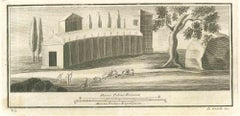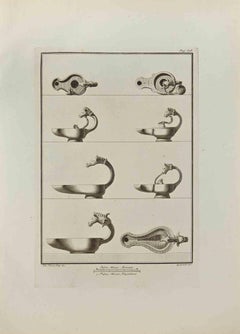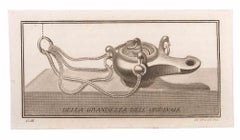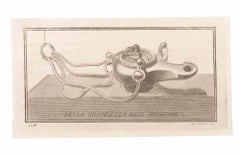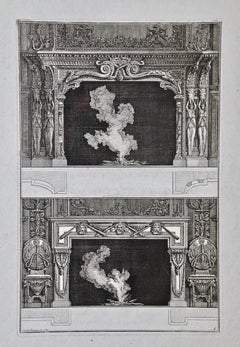Filippo de Grado Prints and Multiples
1
to
4
27
23
4
23
4
Overall Height
to
Overall Width
to
25
2
13
6
6
5
5
3
3
3
3
2
2
2
2
2
2
2
2
2
1
1
27
27
27
979
700
662
626
27
Artist: Filippo de Grado
Roman Fresco - Etching by Filippo de Grado - 18th Century
By Filippo de Grado
Located in Roma, IT
Roman Fresco from "Antiquities of Herculaneum" is an etching on paper realized by Filippo De Grado in the 18th Century.
Signed on the plate.
Good conditions.
The etching belongs t...
Category
18th Century Old Masters Filippo de Grado Prints and Multiples
Materials
Etching
Oil Lamp With Heads of Animals - Etching by Filippo de Grado - 18th Century
By Filippo de Grado
Located in Roma, IT
Oil Lamp With Heads of Animals from "Antiquities of Herculaneum" is an etching on paper realized by Filippo De Grado in the 18th Century.
Signed on the plate.
Good conditions.
The etching belongs to the print suite “Antiquities of Herculaneum Exposed” (original title: “Le Antichità di Ercolano Esposte”), an eight-volume volume of engravings of the finds from the excavation of the ruins of Herculaneum in the Kingdom of Naples (now Campania, Italy).
It was published between 1757 and 1792 by the Regia Stamperia, and copies were delivered to selected recipients across Europe.
Despite the title, the Antiquity of Herculaneum shows objects from all the excavations undertaken by the Bourbons in the Gulf of Naples. These include Pompeii, Stabia and two sites of Herculaneum: Resina and Portici.
The Bourbon King Carlo appointed fifteen scholars creating a new “Herculaneum Academy” to study the artifacts and publish the results of the archaeological excavations of the sites.
The engravings are of high quality and the accompanying text shows a large scholarship.
They were realized by 25 prominent artists involved by the King to prepare drawings and engravings on the finds, among which we can find Giovanni Elia Morghen, Carlo Nolli, Luigi Vanvitelli, and Giovanni Battista Casanova.
The “Antiquities” was designed more to amaze readers with the quality of the objects in the collection of the King of Naples than to be used in research., following and increasing the interest of 18th-century society for the classical culture and Art in particular.
Through the exaltation of the classical concept of proportions and harmony, the book was of inspiration to the neoclassical movement in Europe, giving artists and decorators access to a huge shop of Hellenistic motifs.Oil Lamp With Animals...
Category
18th Century Old Masters Filippo de Grado Prints and Multiples
Materials
Etching
Temple With Sphinx - Etching by Filippo de Grado - 18th Century
By Filippo de Grado
Located in Roma, IT
Temple With Sphinx from "Antiquities of Herculaneum" is an etching on paper realized by Filippo De Grado in the 18th Century.
Signed on the plate.
Good conditions and aged with som...
Category
18th Century Old Masters Filippo de Grado Prints and Multiples
Materials
Etching
Oil Lamp to Hang - Etching by Filippo de Grado - 18th Century
By Filippo de Grado
Located in Roma, IT
Oil Lamp to Hang is an Etching realized by Filippo de Grado (1705-1780).
The etching belongs to the print suite “Antiquities of Herculaneum Exposed” (original title: “Le Antichità ...
Category
18th Century Old Masters Filippo de Grado Prints and Multiples
Materials
Etching
Oil Lamp to Hang - Etching by Filippo de Grado - 18th Century
By Filippo de Grado
Located in Roma, IT
Oil Lamp to Hang is an Etching realized by Filippo de Grado (1705-1780).
The etching belongs to the print suite “Antiquities of Herculaneum Exposed” (original title: “Le Antichità ...
Category
18th Century Old Masters Filippo de Grado Prints and Multiples
Materials
Etching
Oil Lamp With Decoration - Etching by Filippo de Grado - 18th Century
By Filippo de Grado
Located in Roma, IT
Oil Lamp With Decoration is an Etching realized by Filippo de Grado (1705-1780).
The etching belongs to the print suite “Antiquities of Herculaneum Exposed” (original title: “Le An...
Category
18th Century Old Masters Filippo de Grado Prints and Multiples
Materials
Etching
Ancient Greek Coins - Etching by Filippo de Grado - 18th Century
By Filippo de Grado
Located in Roma, IT
Ancient Greek Coins from the series "Antiquities of Herculaneum" is an etching on paper realized by Filippo De Grado in the 18th Century.
Good conditions.
Signed on the lower.
The...
Category
Late 18th Century Old Masters Filippo de Grado Prints and Multiples
Materials
Etching
Oil Lamp to Hang - Etching by Filippo de Grado - 18th Century
By Filippo de Grado
Located in Roma, IT
Oil Lamp to Hang is an Etching realized by Filippo de Grado (1705-1780).
The etching belongs to the print suite “Antiquities of Herculaneum Exposed” (original title: “Le Antichità ...
Category
18th Century Old Masters Filippo de Grado Prints and Multiples
Materials
Etching
Cupid In Pompeian Fresco - Etching by Filippo de Grado - 18th Century
By Filippo de Grado
Located in Roma, IT
Cupid In Pompeian Fresco from "Antiquities of Herculaneum" is an etching on paper realized by Filippo De Grado in the 18th Century.
Signed on the plate.
Good conditions with some f...
Category
18th Century Old Masters Filippo de Grado Prints and Multiples
Materials
Etching
Oil Lamp to Hang - Etching by Filippo de Grado - 18th Century
By Filippo de Grado
Located in Roma, IT
Oil Lamp to Hang is an Etching realized by Filippo de Grado (1705-1780).
The etching belongs to the print suite “Antiquities of Herculaneum Exposed” (original title: “Le Antichità ...
Category
18th Century Old Masters Filippo de Grado Prints and Multiples
Materials
Etching
Ancient Still Life 4 - Etching by Filippo de Grado - 18th Century
By Filippo de Grado
Located in Roma, IT
Still Life from "Antiquities of Herculaneum" is an etching on paper realized by Filippo de Grado e Vincenzo Campana in the 18th Century.
Signed on the plate.
Good conditions with s...
Category
18th Century Old Masters Filippo de Grado Prints and Multiples
Materials
Etching
Faces Of Hercolaneum - Etching by Filippo de Grado - 18th Century
By Filippo de Grado
Located in Roma, IT
Ancient Roman Frescofrom the series "Antiquities of Herculaneum", is an etching on paper realized by Filippo De Grado in the 18th Century.
Good conditions.
Signed in the lower.
Th...
Category
Late 18th Century Old Masters Filippo de Grado Prints and Multiples
Materials
Etching
Ancient Roman Faces - Etching by Filippo de Grado - 18th Century
By Filippo de Grado
Located in Roma, IT
Ancient Roman Fresco from the series "Antiquities of Herculaneum", is an etching on paper realized by Filippo De Grado in the 18th Century.
Good conditions.
Signed on the lower.
T...
Category
Late 18th Century Old Masters Filippo de Grado Prints and Multiples
Materials
Etching
Roman Inscriptions in Herculaneum - Etching by Filippo de Grado - 18th Century
By Filippo de Grado
Located in Roma, IT
Ancient Roman Inscriptions in Herculaneum, from the series "Antiquities of Herculaneum Exposed", is anetching realized by Filippo de Grado in the lat...
Category
Late 18th Century Old Masters Filippo de Grado Prints and Multiples
Materials
Etching
Ancient Roman Fresco Herculaneum - Etching by Filippo de Grado - 18th Century
By Filippo de Grado
Located in Roma, IT
Ancient Roman Fresco "Antiquities of Herculaneum Exposed", is an etching realized by Filippo de Grado in the late 18th century.
Signed on The plate
Good conditions.
The etching be...
Category
Late 18th Century Old Masters Filippo de Grado Prints and Multiples
Materials
Etching
Ancient Roman Fresco Herculaneum - Etching by Filippo de Grado - 18th Century
By Filippo de Grado
Located in Roma, IT
Ancient RomanFresco "Antiquities of Herculaneum Exposed", is an etching realized by Filippo de Grado in the late 18th century.
Signed on The plate
Good conditions.
The etching bel...
Category
Late 18th Century Old Masters Filippo de Grado Prints and Multiples
Materials
Etching
Ancient RomanFresco - Etching by Filippo de Grado - 18th Century
By Filippo de Grado
Located in Roma, IT
Ancient RomanFresco "Antiquities of Herculaneum Exposed", is an etching realized by Filippo de Grado in the late 18th century.
Signed on The plate
Good conditions.
The etching bel...
Category
Late 18th Century Old Masters Filippo de Grado Prints and Multiples
Materials
Etching
Ancient Still Life of Hercolaneum - Etching by Filippo de Grado - 18th Century
By Filippo de Grado
Located in Roma, IT
Ancient Roman Fresco "Antiquities of Herculaneum Exposed", is an etching realized by Filippo de Grado in the late 18th century.
Signed on The plate
Good conditions.
The etching be...
Category
Late 18th Century Old Masters Filippo de Grado Prints and Multiples
Materials
Etching
Ancient Roman Fresco Herculaneum - Etching by Filippo de Grado - 18th Century
By Filippo de Grado
Located in Roma, IT
Ancient RomanFresco "Antiquities of Herculaneum Exposed", is an etching realized by Filippo de Grado in the late 18th century.
Signed on The plate
Good conditions.
The etching bel...
Category
Late 18th Century Old Masters Filippo de Grado Prints and Multiples
Materials
Etching
Ancient Roman Fresco Herculaneum - Etching by Filippo de Grado - 18th Century
By Filippo de Grado
Located in Roma, IT
Ancient RomanFresco "Antiquities of Herculaneum Exposed", is an etching realized by Filippo de Grado in the late 18th century.
Signed on The plate
Good conditions.
The etching bel...
Category
Late 18th Century Old Masters Filippo de Grado Prints and Multiples
Materials
Etching
Ancient Roman Fresco Herculaneum - Etching by Filippo de Grado - 18th Century
By Filippo de Grado
Located in Roma, IT
Ancient Roman Still Life in Herculaneum, from the series "Antiquities of Herculaneum Exposed", is an etching realized by Filippo de Grado in the late 18th century.
Signed on The pla...
Category
Late 18th Century Old Masters Filippo de Grado Prints and Multiples
Materials
Etching
Cupids - Etching by Filippo de Grado - 18th Century
By Filippo de Grado
Located in Roma, IT
Cupids from the series "Antiquities of Herculaneum", is an original etching on paper realized by Filippo de Grado in the 18th Century.
Signed on the plate.
Good conditions with som...
Category
Late 18th Century Old Masters Filippo de Grado Prints and Multiples
Materials
Etching
Ancient Roman Drawing - Original Etching by Filippo de Grado - 18th Century
By Filippo de Grado
Located in Roma, IT
Ancient Roman Drawing, from the series "Antiquities of Herculaneum", is an original etching on paper realized by Filippo de Grado in the 18th century.
Signed on the plate.
Good con...
Category
18th Century Old Masters Filippo de Grado Prints and Multiples
Materials
Etching
Ancient Roman Fresco - Original Etching by Filippo de Grado - 18th Century
By Filippo de Grado
Located in Roma, IT
Ancient Roman Fresco, from the series "Antiquities of Herculaneum", is an original etching on paper realized by Filippo de Grado in the 18th century.
Signed on the plate.
Good cond...
Category
18th Century Old Masters Filippo de Grado Prints and Multiples
Materials
Etching
Ancient Roman Still Life - Original Etching by Filippo De Grado - 18th Century
By Filippo de Grado
Located in Roma, IT
Ancient Roman Still Life, from the series "Antiquities of Herculaneum", is an original etching on paper realized by Filippo De Grado in the 18th century.
Signed on the plate.
Good ...
Category
18th Century Old Masters Filippo de Grado Prints and Multiples
Materials
Etching
Ancient Roman Fresco - Original Etching by Filippo de Grado - 18th Century
By Filippo de Grado
Located in Roma, IT
Ancient Roman Drawing, from the series "Antiquities of Herculaneum", is an original etching on paper realized by Filippo de Grado in the 18th century.
Signed on the plate.
Good con...
Category
18th Century Modern Filippo de Grado Prints and Multiples
Materials
Etching
Ancient Roman Bust - Etching by Filippo De Grado - Late 18 Century
By Filippo de Grado
Located in Roma, IT
Ancient Roman Bust, from the series "Antiquities of Herculaneum Exposed", is an original etching on paper realized by Filippo De Grado.
Signed on the plate, on the lower right.
Ver...
Category
Late 18th Century Modern Filippo de Grado Prints and Multiples
Materials
Etching
Related Items
Purple magnolia 3 - Contemporary Figurative Drypoint Etching Print Flower Floral
By Marta Wakula-Mac
Located in Warsaw, PL
MARTA WAKUŁA-MAC: Master of Arts in Fine Art Education- Diploma in Fine Art Printmaking at the Institute of Art, Pedagogical University, Krakow, 2003. Member of Graphic Studio Dubl...
Category
2010s Contemporary Filippo de Grado Prints and Multiples
Materials
Paper, Drypoint, Etching
18th C. Piranesi Fireplace Designs based on Ancient Architectural Styles
By Giovanni Battista Piranesi
Located in Alamo, CA
These two Giovanni Battista Piranesi 18th century etchings of fireplace designs on one sheet is plate 6 from his publication 'Diverse Maniere d'adornare i cammini ed ogni altra parte degli edifizi desunte dall'architettura Egizia, Etrusca, e Greca con un Ragionamento Apologetico in defesa dell'Architettura Egizia, e Toscana, opera del Cavaliere Giambattista Piranesi...
Category
Mid-18th Century Old Masters Filippo de Grado Prints and Multiples
Materials
Etching
Christ and the Woman of Samaria Among Ruins by James Bretherton after Rembrandt
By Rembrandt van Rijn
Located in Middletown, NY
Bretherton, James (After Rembrandt van Rijn).
Christ and the Woman of Samaria Among Ruins.
London: c 1775.
Etching on light cream laid paper, 4 3/4...
Category
18th Century Old Masters Filippo de Grado Prints and Multiples
Materials
Handmade Paper, Etching, Laid Paper
Fabricius (Ponte Cestio) Bridge : Framed 18th C. Piranesi Architectural Etching
By Giovanni Battista Piranesi
Located in Alamo, CA
This framed 18th century etching by Giovanni Battista Piranesi is entitled "Dimostransi nella Tav. presente la Pianta, ed Elevazione del Ponte, oggi detto Quattro Capi egli è antichissimo, e chiamavasi Fabrizio da L. Fabrizio Presid. delle Strade, che lo fabbrico' nel fine della Repubblica. "(The Plan and Elevation of the Bridge, today called Quattro Capi. The architect is very ancient, and was called Fabrizio da L. Fabrizio Presid. delle Strade, who built it at the end of the Republic). This is plate 18 in volume 4 of Piranesi's "Le antichita romane opera di Giambatista Piranesi architetto veneziano" (Roman antiquities by Giambatista Piranesi Venetian architect). It was published in Rome in 1756-1757.
This etching depicts the plan and elevation of the bridge now called the Ponte dei Quattoro Capi or Ponte Cestio (Bridge of the Four Heads), which in antiquity was called the Bridge of Fabricius after L. Fabricius, the Superintendant of the Streets who built it at the end of the Republic, around 62 BC. It was also been known in the Middle Ages as ‘Ponte Giudeo’ (Bridge of the Jews). The bridge crossed from the left bank or northeast side of the Tiber River to Tiber Island...
Category
1750s Old Masters Filippo de Grado Prints and Multiples
Materials
Etching
H 25.63 in W 30.5 in D 0.36 in
Giovanni Piranesi Etching of Ancient Roman Architecture, 18th Century
By Giovanni Battista Piranesi
Located in Alamo, CA
"Veduta del Sepolcro della Famiglia Plauzia per la Strada Che Conduce da Roma a Tivoli vicino a Ponte Lugano" from "Le Antichità Romane" (Roman Antiquities), one of the most famous works by Piranesi. "Antichita" illustrates the tombs along the Appian Way...
Category
Early 18th Century Old Masters Filippo de Grado Prints and Multiples
Materials
Drypoint, Engraving, Etching
H 24.38 in W 31.75 in D 0.75 in
The Windmill by François Vivares, after Rembrandt
By Rembrandt van Rijn
Located in Middletown, NY
Engraving on cream laid paper, 8 x 5 7/8 inches (202 x 149 mm), trimmed at the platemark. Adhered at each corner to a small sheet of archival laid paper. Horizontal edge loss at the ...
Category
Mid-18th Century Old Masters Filippo de Grado Prints and Multiples
Materials
Handmade Paper, Laid Paper, Etching
"Limon Straitus Amalphitanus" Ferrari 17th C. Hand Colored Engraving of Lemons
By Giovanni Battista Ferrari
Located in Alamo, CA
This 17th century hand-colored engraving of a lemon entitled "Limon Straitus Amalphitanus" is Plate 249 from Giovanni Baptista Ferrari's publication "Hesperides, sive, De Malorum Aur...
Category
17th Century Old Masters Filippo de Grado Prints and Multiples
Materials
Engraving
H 23.25 in W 18.5 in D 0.75 in
Samuel Bak Surrealist Etching Israeli Bezalel Artist "Hidden Pear", Fruit Bowl
By Samuel Bak
Located in Surfside, FL
HIDDEN PEAR, color etching, signed in pencil, numbered 7/50, Jerusalem Print workshop blind stamp, image 7 ½ x 5 ½”, sheet 15 x 10 ¼”.
Samuel Bak (born 12 August 1933) is a Polish- American painter and writer who survived the Holocaust and immigrated to Israel in 1948. Since 1993, he has lived in the United States.
Samuel Bak was born in Wilno, Poland, Bak was recognized from an early age as having an artistic talent. He describes his family as secular, but proud of their Jewish identity.
By 1939 when Bak was six years old, the war began and Wilno was transferred from Poland to Lithuania. When Wilno was occupied by the Germans on June 24, 1941, Bak and his family were forced to move into the ghetto. At the age of nine, he held his first exhibition inside the Ghetto. Bak and his mother sought refuge in a Benedictine convent where a Catholic nun named Maria Mikulska tried to help them. After returning to the ghetto, they were deported to a forced labour camp, but took shelter again in the convent where they remained in hiding until the end of the war.
By the end of the war, Samuel and his mother were the only members of his extensive family to survive. His father, Jonas, was shot by the Germans in July 1944, only a few days before Samuel's own liberation. As Bak described the situation, "when in 1944 the Soviets liberated us, we were two among two hundred of Vilna's survivors--from a community that had counted 70 or 80 thousand." Bak and his mother as pre-war Polish citizens were allowed to leave Soviet-occupied Wilno and travel to central Poland, at first settling briefly in Lodz. They soon left Poland and traveled into the American occupied zone of Germany. From 1945 to 1948, he and his mother lived in Displaced Persons camps in Germany. He spent most of this period at the Landsberg am Lech DP camp in Germany. It was there he painted a self-portrait shortly before repudiating his Bar Mitzvah ceremony. Bak also studied painting in Munich during this period, and painted "A Mother and Son", 1947, which evokes some of his dark memories of the Holocaust and escape from Soviet-occupied Poland. In 1948, Bak and his mother immigrated to Israel. In 1952, he studied art at the Bezalel Academy of Arts and Design in Jerusalem. After serving in the Israel Defense Forces, he continued his studies in Paris (from 1956 at the École nationale supérieure des Beaux-Arts) and spent various periods of time in Rome, Paris, Switzerland and Israel before settling permanently in the United States. In 2001, Bak returned to Vilnius for the first time and has since visited his hometown several times. Samuel Bak is a conceptual artist with elements of post-modernism as he employs different styles and visual vernaculars, i.e. surrealism (Salvador Dali, Rene Magritte), analytical cubism (Picasso), pop art (Andy Warhol, Roy Lichtenstein) and quotations from the old masters. The artist never paints direct scenes of mass death. Instead, he employs allegory, metaphor and certain artistic devices such as substitution: toys instead of the murdered children who played with them, books, instead of the people who read them. Further devices are quotations of iconographical prototypes, i.e. Michelangelo's "Creation of Adam" on the Sistine Ceiling or Albrecht Dürer's famous engraving entitled "Melencholia" . In the late 1980s Bak opened up about his paintings, stating they convey “a sense of a world that was shattered.” He turns these prototypes into ironical statements. Irony in the art of Samuel Bak does not mean parody or derision, but rather disenchantment, and the attempt to achieve distance from pain. Recurring symbols are: the Warsaw Ghetto Child, Crematorium Chimneys or vast backgrounds of Renaissance landscape that symbolize the indifference of the outside world. These form a disturbing contrast with the broken and damaged images in the foreground. Samuel Bak's paintings cause discomfort, they are a warning against complacency, a bulwark against collective amnesia with reference to all acts of barbarism, worldwide and throughout the ages, through his personal experience of genocide.
In Bak's piece entitled Trains Bak creates a vast grey landscape with large mounts creating the structure of a train. Massive taper candles burn in the distance further down the train tracks, surrounding an eruption. The smoke from the candles and volcano pour into a sky of dark ominous clouds that lurk over the landscape. Here Bak has created a whole new meaning for “trains.” Many of Bak’s pieces incorporate aspects of Jewish culture and the holocaust with a dark and creative twist, such as Shema Israel, Alone, and Ghetto. Chess as a theme of life has always fascinated Bak. In the DP camps and in Israel, he often played chess with his stepfather Markusha. Underground II, 1997, portrays chess pieces in a sunken, subterranean evocation of the Vilna ghetto.
Select Group Exhibitions
Graphic Works by Contemporary Israeli artists - Israel Museum, Jerusalem
Avraham Ofek, Igael Tumarkin, Shmuel Bak, Avigdor Arikha,Jakob Steinhardt, Anna Ticho
Artist and Society in Israeli Art, Tel Aviv Museum, Tel Aviv Moshe Gat, Marcel Janco, Yohanan Simon, Ruth Schloss, Menashe Kadishman, Samuel Bak, Yosl Bergner.
Selected museum exhibitions
Bezalel Museum, Jerusalem, Israel – 1963
Tel Aviv Museum, Tel Aviv, Israel – 1963
Rose Museum, Brandeis University, Waltham, MA – 1976
Germanisches National Museum, Nuremberg, Germany – 1977
Heidelberg Museum, Heidelberg, Germany – 1977
Haifa University, Haifa, Israel – 1978
Kunstmuseum, Düsseldorf, Germany – 1978
Jüdisches Museum, Stadt Frankfurt am Main, Germany – 1993
Hebrew Union College, Jewish Institute of Religion, New York, NY – 1994
South African Jewish Museum, Cape Town, South Africa. 2013-2014.
B’nai B’rith Klutznick National Jewish Museum, Washington, DC – 1997
Holocaust Museum Houston, Houston, TX – 1997
National Museum of Lithuania, Vilnius, Lithuania – 2001
Felix Nussbaum...
Category
20th Century Surrealist Filippo de Grado Prints and Multiples
Materials
Etching
Frontispiece with stepped fountain.
By Karel Dujardin
Located in Middletown, NY
Dujardin, Karel. Frontispiece with stepped fountain; a stone wall with water spout pouring water into a rectilinear basin, from which a second spout pour...
Category
Mid-17th Century Old Masters Filippo de Grado Prints and Multiples
Materials
Handmade Paper, Etching, Laid Paper
Venus Lamenting over the Death of Adonis
By Herman van Swanevelt
Located in Middletown, NY
c. 1654. Etching with engraving on thin laid paper with an early and large unidentified watermark with a sundial and a many-pointed star, and an unidentified collector's stamp in the...
Category
Mid-17th Century Old Masters Filippo de Grado Prints and Multiples
Materials
Handmade Paper, Engraving, Etching
Ruins of the Roman Baths of Belisarius: A 19th C. Etching by Luigi Rossini
By Luigi Rossini
Located in Alamo, CA
This early 19th century etching entitled "Veduta degl' Avanzi delle Torri di Belisario Dalla parte che guarda l' Interno della Città, vicino a Porta S. Giovanni, A. Mura Aureliane" (...
Category
1820s Old Masters Filippo de Grado Prints and Multiples
Materials
Etching
H 27 in W 31 in D 1.5 in
The Basilica of St. Paul in Rome, Early 19th Century Etching by Luigi Rossini
By Luigi Rossini
Located in Alamo, CA
"Rovina della gran Basilica di S. Paolo fueri le mura accaduta" (View of the Ruins of the Great Triumphal Arch of S. Paolo Fuori le Mura) from "Le Antichita Romane" (Ancient Rome), published in Rome in 1823. It depicts the destruction of the Basilica of St. Paul after the fire of 1823. People stand in the road and on the right observing the damage amid debris, which includes many fragments of columns.
The etching is presented in a silver-color wood frame with an off-white double mat with a black inner mat. There are a few small spots, but it is otherwise in very good condition. See item # LU117324669722 for another Rossini etching...
Category
1820s Old Masters Filippo de Grado Prints and Multiples
Materials
Etching
H 27.5 in W 37.13 in D 0.88 in
Filippo De Grado prints and multiples for sale on 1stDibs.
Find a wide variety of authentic Filippo de Grado prints and multiples available for sale on 1stDibs. You can also browse by medium to find art by Filippo de Grado in etching and more. Much of the original work by this artist or collective was created during the 18th century and is mostly associated with the Old Masters style. Not every interior allows for large Filippo de Grado prints and multiples, so small editions measuring 6 inches across are available. Filippo de Grado prints and multiples prices can differ depending upon medium, time period and other attributes. On 1stDibs, the price for these items starts at $154 and tops out at $512, while the average work can sell for $258.
